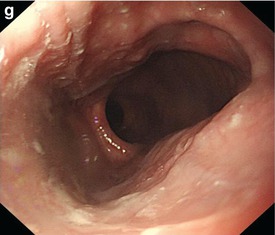(1)
Gastroenterology and hepatology, Chinese PLA General Hospital, Beijing, China, People’s Republic
Abstract
In our practice of treating esophageal achalasia with tunnel technique, we found that the morphology of the esophageal lumen greatly affects the establishment of a submucosal tunnel in the esophagus especially in patient with esophageal achalasia, so we reviewed the characteristics of the morphology of the middle and the lower parts of the esophagus in patients with esophageal achalasia, which included three endoscopically detected intraluminal structures: multi-ring structure, crescent-like structure and diverticulum structure, and finally proposed an endoscopic classification of esophageal lumen. This new classification was named Ling classification. The morphology of the esophageal wall is a key point during carrying out of tunnel technique, because it affects complications of tunnel technique. Although the Ling classification was initially proposed to characterize the esophageal wall of patients with esophageal achalasia, the main purpose of this classification is to assist in investigation of the indications and contraindications of esophageal tunnel technique. With the extensive development of tunnel technique, the Ling classification can be used to characterize the esophageal lumen for the side wall that targeted for tunnel establishment.
In our practice of treating esophageal achalasia with tunnel technique, we found that the morphology of the esophageal lumen greatly affects the establishment of a submucosal tunnel in the esophagus especially in patient with esophageal achalasia, so we reviewed the characteristics of the morphology of the middle and the lower parts of the esophagus in patients with esophageal achalasia, which included three endoscopically detected intraluminal structures: multi-ring structure, crescent-like structure and diverticulum structure, and finally proposed an endoscopic classification of esophageal lumen. This new classification was named Ling classification [1, 2].
3.1 Ling Classification
There are three types according to the Ling classification (Fig. 3.1): Type I, smooth without multi-ring, crescent-like structure or diverticulum structure; type II, with multi-ring or crescent-like structure but without diverticulum structure; and type III, with diverticulum structure.




Fig. 3.1
Types of Ling classification: (a) type Ling I, (b) type Ling IIa, (c) type Ling IIb, (d) type Ling IIc, (e) type Ling IIIl, (f) type Ling IIIr, (g) type Ling IIIlr
Type II is subdivided into three types including Ling IIa, Ling IIb and Ling IIc. And type III is also subdivided into three types including Ling IIIl, Ling IIIr and Ling IIIlr. The subtypes are classified according to the following criteria. Type Ling IIa should have the multi-ring structure, type Ling IIb should have the crescent-like structure with the midpoint of its inner edge not larger than one-third of the esophageal lumen, type Ling IIc, should have the crescent-like structure with the midpoint of its inner edge over one-third of the esophageal lumen, type Ling IIIl should have the diverticulum structure in the left wall of esophagus, type Ling IIIr should have the diverticulum structure in the right wall of esophagus and type Ling IIIlr should have the diverticulum structure in both the left and right wall of esophagus (Table 3.1).
Table 3.1




The criteria of Ling classification
Stay updated, free articles. Join our Telegram channel

Full access? Get Clinical Tree








